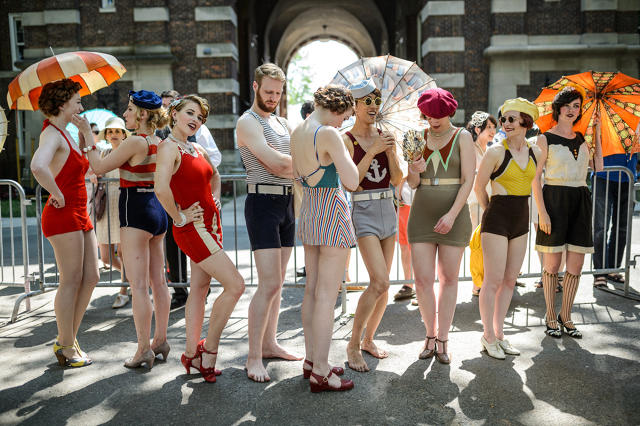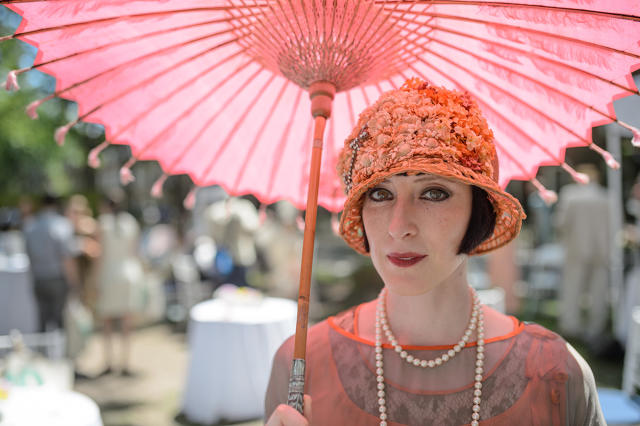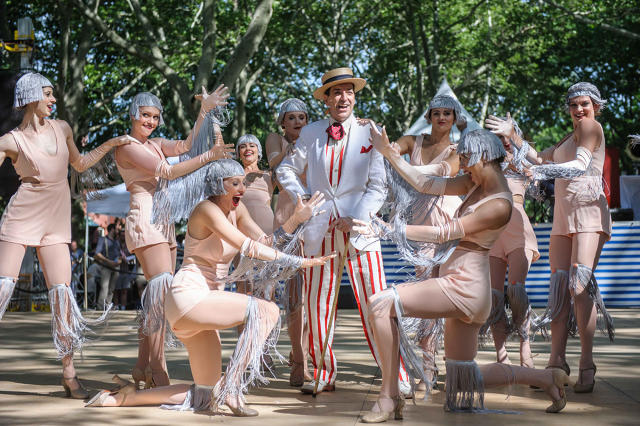How One Jazz-Age-Obsessed Man Transformed His Passion Into A Spectacular, Moneymaking Party
Michael Arenella adores the 1920s. So do the 20,000 people who attend his wildly successful, St. Germain-sponsored, time machine of a bash.
For two weekends a year, a curious spectacle can be seen on Governors Island, the public park just off the coast of Lower Manhattan.
Set foot on the island on the right day in June or August, and you very well might hear the distinct sound of the roaring ’20s filling the air, with large orchestras playing hot jazz numbers. Flappers appear to have walked right out of an F. Scott Fitzgerald novel into the present day. They are absolutely everywhere, decked out in elaborate sparkly dresses, long strings of pearls, and headdresses. And the men aren’t too shabby, either. They’re wearing their finest vests and straw boater hats, often boasting neatly groomed curlicue mustaches.

And if people watching isn’t entertaining enough, there are other diversions, as well: you can take in displays of grand 1920s cars and gramophones playing tunes that were all the rage nearly 100 years ago. You can have your portrait painted in a vintage style. You can learn to dance the Charleston.
Welcome to the Jazz Age Lawn Party, an event that is now 10 years old and draws crowds of up to 20,000 merrymakers over the two weekends. Tickets to the party will run you anywhere from $35 to several hundreds of dollars if you want a VIP table complete with a private chef and bartender. And these days, tickets sell out fast: admissions to the August 15-16 event are already in short supply. But unlike the many other blockbuster summer festivals and parties in New York, this event was not invented by a team of branding experts or marketers. In fact, the man behind it, Michael Arenella, never expected to be the organizer of one of New York’s hippest events.
Arenella is a musician who leads his 11-piece Dreamland Orchestra that performs jazz-age classics. The Jazz Age Lawn Party was something of an accident. In 2005, when Governors Island was undergoing a transformation into a public park after two centuries of being a military base, the city planners in charge of the transition spotted Arenella’s band performing at an Isaac Mizrahi product launch organized by Target. They were intrigued by his sound and wondered whether he might be willing to bring the Dreamland Orchestra to Governors Island on a summer afternoon so that New Yorkers could enjoy a free concert.

Arenella was thrilled. At that first event, only about 50 people showed up, but somehow the island, which had lay fallow for many years, suddenly came alive. “The island has a bit of a haunted quality to it,” Arenella says. “It feels untouched. It is reminiscent of say, Gatsby’s loneliness, in that it has a certain isolated quality to it. But when we play music there, it gives New Yorkers an opportunity to visit a place where time stands still, and make it come to life.”
It was very clear to everyone involved that the event had the potential to be much grander in scale, so the Governor’s Island Preservation and Education Corporation invited Arenella to take charge and create the party of his dreams. And anybody who spends even a few minutes with Arenella realizes that the man’s dreams are saturated with the colors and sounds of the 1920s. He first fell in love with jazz-era music as a second-grader playing the trombone in band class. “It always seemed like my music,” he says. “It brought me immediate joy. Everything after that was just a product of studying it and immersing myself in that time.”
Today, Arenella’s entire life is influenced by the roaring ’20s. “The music was the seed from which the tree grew,” he says. “I began to learn about the literature and, of course, the fashion of this time.” He goes about his days in dapper vintage suits, well-shined, two-tone shoes, and usually a hat. He drives a baby-blue 1920s Buick motorcar. His home is full of gramophones and vintage pictures. His bookshelves are lined with the works of Dorothy Parker and Gertrude Stein. In his vocation as a musician, he’s committed to introducing new audiences to the songs and the culture of this time. “I feel like there’s a gap in the Zeitgeist of our time, when it comes to jazz-era music,” he tells. “It’s a shame, because I think it has something very valuable to offer us.”

To Arenella, the culture of the jazz era isn’t just fascinating: it can also resonate with us on a more profound level. Take flappers, for instance. He points out that the women from this period believed they could be both sexy and also not overtly sexual. “It was all about freedom and ease of motion,” he says. “The dresses eschewed Victorian bodices and corsets. They were rectangular and meant to hide the body in a way. It was a socially subversive concept that blurred the gender lines.” He also sees similarities in terms of the political climate. In the 1920s, people were still reeling from the impact of World War I, just like we are still coping with the ramifications of wars being fought throughout the Middle East. “We’re looking for reasons to celebrate and get away from the gloom and doom,” he says. To Arenella, the music and culture of the jazz era can speak to us today.
With the Jazz Age Lawn Party, all of Arenella’s passion for this moment in history comes to life. Over the years, he has slowly grown the event. Early on, the event was free and created in partnership with Governors Island, but after two years, the island’s management invited Arenella to create bigger-scale events in which he could charge an admission fee, but in which he would also be responsible for taking on some of the costs including, for instance, event insurance. By this point, Arenella was completely committed to this party and what it could do, so without a lick of business training, he started to work on the logistics and finances of the event. Soon he had to hire staff members to help with the planning.
First he set up a dance floor and a proper stage, so his orchestra didn’t have to play on the grass. Then came cocktails and nibbles. Before long, there were dance contests, motorcar displays, and gramophone viewings. Then there were fashion shows of bathing beauties and their beaus in old-timey bathing suits. And before long, people started hearing about this unusual event through word of mouth and flocked to buy tickets. And then came the sponsors. Without any outreach on Arenella’s part, St. Germain, the elderflower liqueur brand, asked whether they could be part of the event and sponsor the cocktail operations of the party.
While St. Germain is less than a decade old, the brand is designed to call to mind a different era. Robert Cooper, a third-generation American distiller, was attracted to the old French craft of gathering small batches of elderflowers, which are only mature enough during one week in the year, in order to turn it into an alcohol. When he launched St. Germain in 2007, he wanted to create an experience for the drinker that called to mind a different time. The bottle he designed is inspired by Art Deco and Belle Epoque art, and all other aspects of the branding are meant to be reminiscent of the 1920s. When Cooper heard about the Jazz Age Lawn Party, a partnership seemed obvious, so he approached Arenella to see how St. Germain could be involved. Apart from the retro feel of the party, St. Germain is a light, effervescent drink that is ideal for summer cocktails, so the Lawn Party was a great fit.
In 2013, St. Germain was acquired by Bacardi, which has continued to keep the brand involved in the party’s proceedings. Michelle Beauchamp, brand managing director of Bacardi North America, explains that while the brand is very new, the challenge when it comes to marketing it is to give the consumer a sense that it is plucked from a different time in history. “St. Germain celebrates things that are beautiful and artisanal from the 1920s, and these are things we try to bring back to life in our branding efforts,” she explains.

From Arenella’s perspective, both the Jazz Age Lawn Party and St. Germain are in the business of building up an elaborate fantasy that takes the guest into another time. “We’re creating a time-warp to take you to a whole new place,” he says. “St Germain doesn’t necessarily have a long history, but they pay such close attention to their aesthetic and creating a timeless brand. That’s really what we’re trying to do as well. It was a good meeting of the minds.”
Today, the event is profitable. While St. Germain remains the party’s biggest sponsor, other small companies have also asked to come on board as sponsors. Arenella is happy about the interest in the party, but he’s also keen to keep the event small. “I like that it has never felt corporate, or something that we are selling hard,” he says. “It has always felt like a gathering of friends.”
Sometimes Aranella sits back and thinks about how funny it is that even though he has always pursued a career as a musician, money has trickled in on its own. “I’m not a businessman, I’m an artist,” Arenella tells me. “That’s what makes me happy, and that’s what I want to do with my life. This whole party was really an attempt to create an event that I would be proud to invite fans of this music to come to. But you know, it’s true what they say: if you do what you love, you’ll never work a day in your life.”
Fast Company , Read Full Story
(114)














